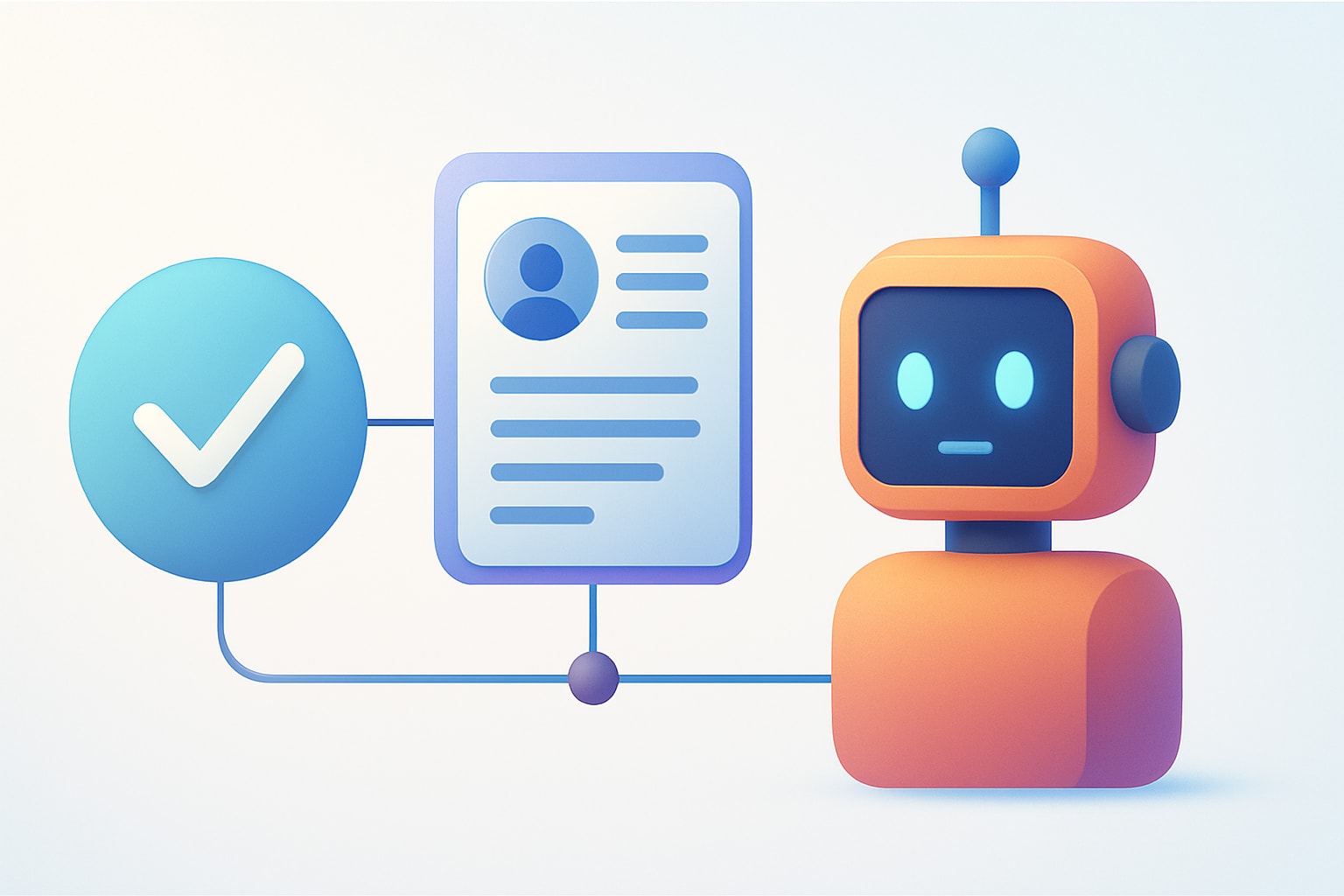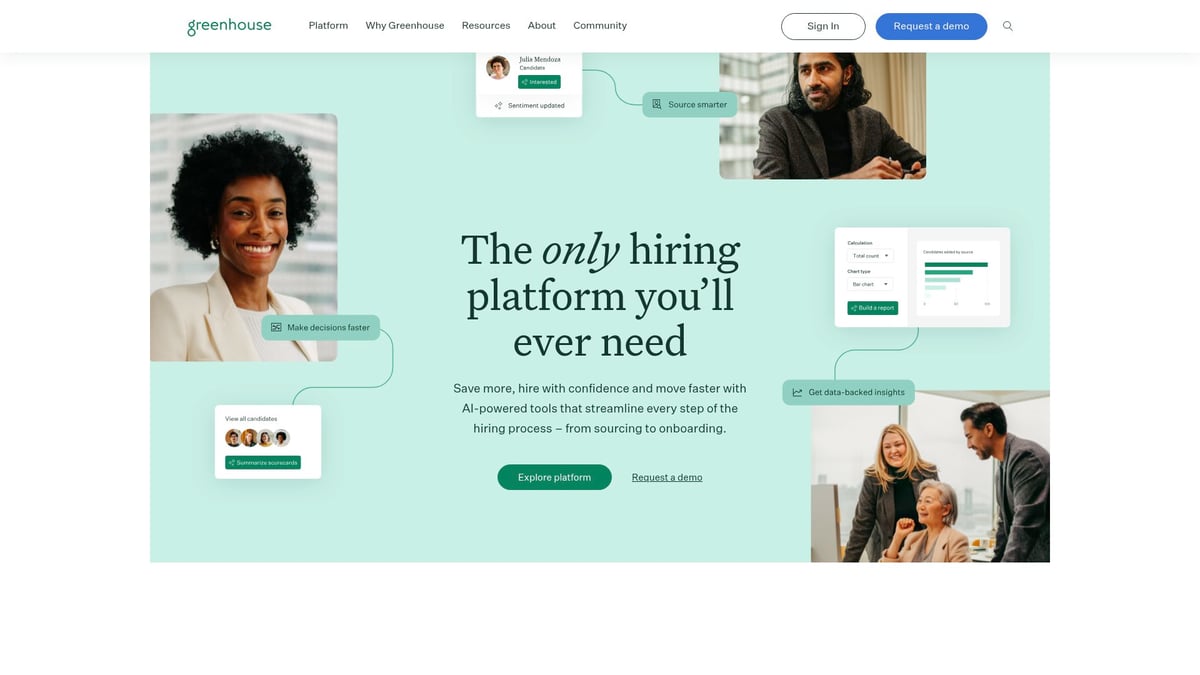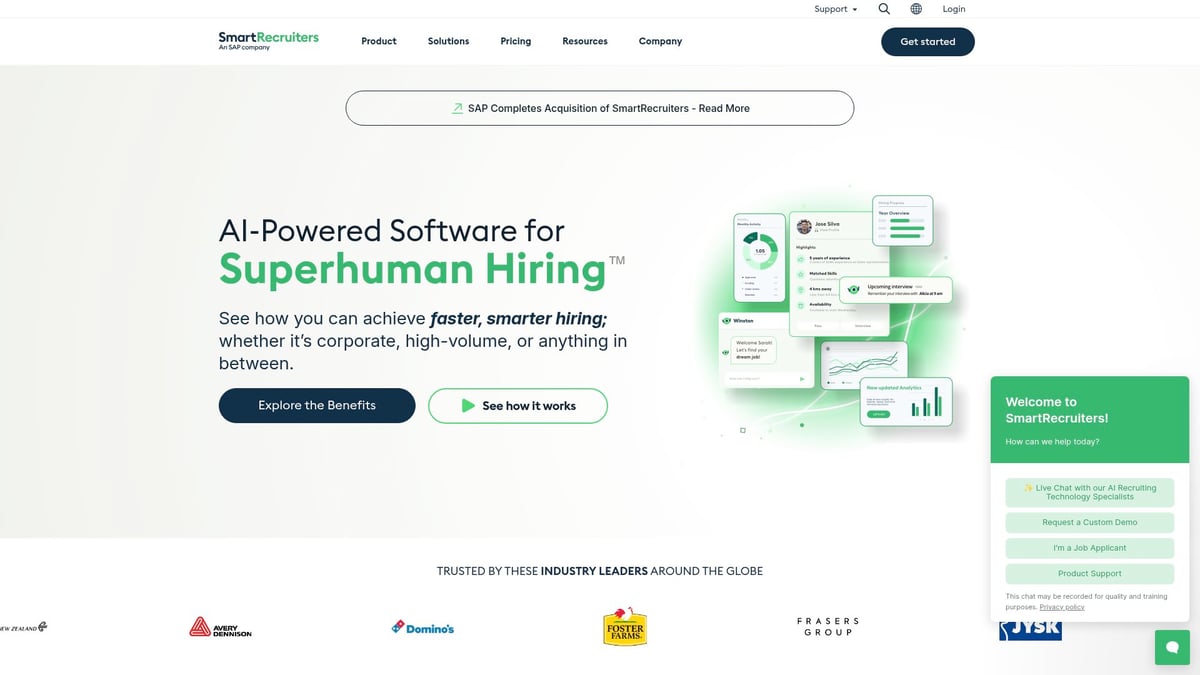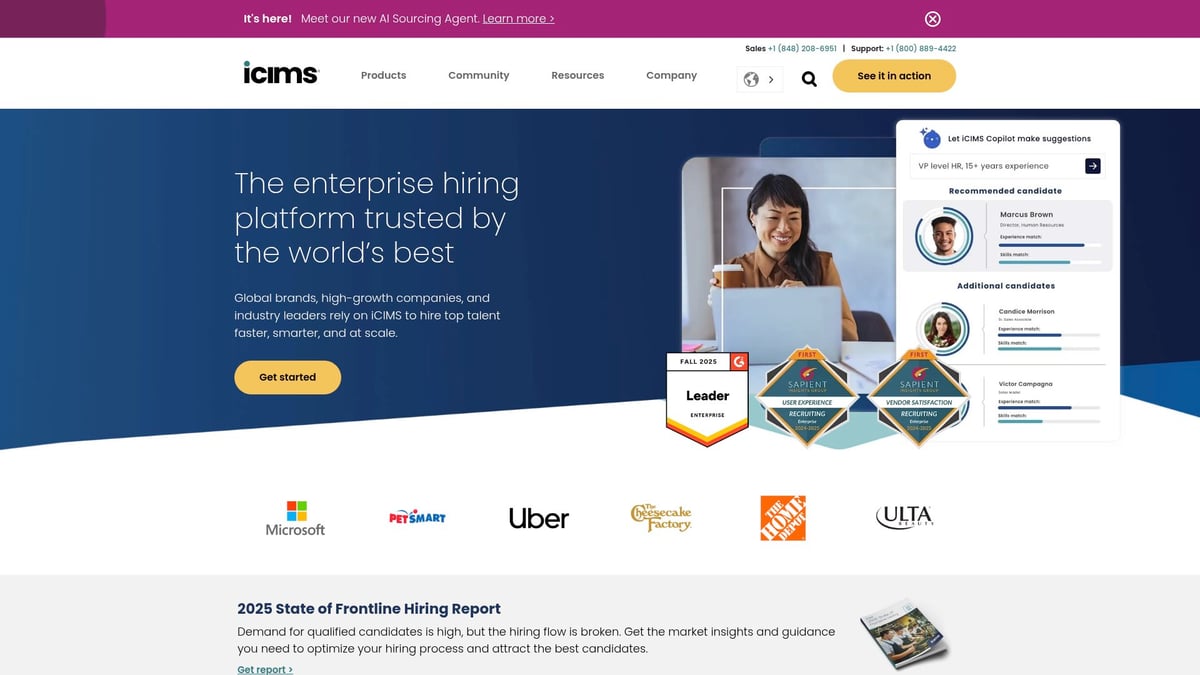July 29, 2025
7 Best Automated Resume Screening Software Picks for 2025

The recruitment landscape is changing fast as more companies rely on automated resume screening software to handle the surge in job applications. From startups to multinational enterprises, organizations are leveraging AI-driven tools to streamline candidate selection and boost hiring efficiency.
In this article, we guide HR professionals, recruiters, and business leaders through the 7 best automated resume screening software solutions for 2025. You will discover each platform’s standout features, pricing, benefits, and unique strengths, helping you choose the right fit for your talent strategy.
Why Automated Resume Screening Software Is Essential in 2025
Recruitment in 2025 faces an unprecedented surge in job applications. With every open role attracting hundreds or even thousands of candidates, manual screening has become a critical bottleneck for hiring teams. The time and effort required to sift through vast volumes of resumes can overwhelm even the most experienced recruiters, leading to delays, burnout, and missed opportunities.
Organizations now turn to automated resume screening software to address these challenges. By leveraging advanced AI algorithms, these tools rapidly analyze, parse, and score resumes based on job requirements. The result is a drastic reduction in screening time, allowing teams to focus on engaging top talent instead of drowning in paperwork. Automated resume screening software helps recruiters move from reactive to proactive talent acquisition, giving them a crucial competitive edge.
Speed is not the only factor. Today’s candidates and recruiters expect accuracy and fairness throughout the hiring process. Automated resume screening software eliminates much of the unconscious bias that can creep into manual reviews. By standardizing evaluation criteria and using data-driven insights, these platforms ensure each applicant receives a fair, objective assessment. This approach not only improves diversity and inclusion but also builds trust with job seekers, who increasingly demand transparency and equal opportunity.
Industry data highlights the rapid adoption of these technologies. According to recent studies, applicant tracking system (ATS) adoption rates have climbed above 90% among large enterprises by 2025, with automated resume screening software integrated into most modern ATS platforms. Candidate volumes have grown by more than 50% from 2023 to 2025, further emphasizing the need for scalable solutions. The rise of remote and hybrid work has expanded talent pools globally, introducing new complexities in language, skills, and compliance that only intelligent automation can manage efficiently.
Many forward-thinking organizations have already transformed their hiring processes with automated resume screening software. For example, global retailers now use AI-driven screening to reduce time-to-hire by weeks and to surface hidden talent from diverse backgrounds. Tech startups leverage these platforms to keep pace with rapid growth, ensuring quality hires without sacrificing candidate experience. For a comprehensive overview of how these solutions are reshaping hiring, the Automated Resume Screening Guide provides detailed insights and best practices.
On the other hand, companies that resist adopting automated resume screening software face significant risks. Manual screening increases the likelihood of bias, inconsistency, and human error. Talented candidates may be overlooked due to fatigue or unconscious preference, while competitors gain an advantage by hiring faster and smarter. In a market where agility and fairness are non-negotiable, relying solely on traditional methods can lead to missed talent, reputational damage, and higher turnover.
Ultimately, automated resume screening software is no longer a luxury but a necessity in 2025. It empowers HR professionals, recruiters, and business leaders to handle scale, complexity, and expectations with confidence. By embracing automation, organizations future-proof their hiring strategies and position themselves for ongoing success in a rapidly evolving talent landscape.
Key Features to Look for in Automated Resume Screening Tools
The landscape of recruitment is evolving rapidly, and selecting the right automated resume screening software can make or break your talent acquisition strategy. With a growing number of applicants and increasing expectations for speed and fairness, understanding the most important features is essential to making an informed decision.
Core Capabilities of Automated Resume Screening Software
At the heart of any effective automated resume screening software are AI-driven parsing, advanced skill matching, and customizable scoring systems. These tools rapidly analyze resumes, extracting key data points and matching them against job requirements with impressive accuracy. The ability to tailor scoring models ensures your unique hiring criteria are reflected in the shortlist.
Modern software goes beyond simple keyword matching, leveraging machine learning to understand context and relevance. This sophistication saves countless hours for recruiters and improves the quality of candidate recommendations. For a comprehensive breakdown, the Key Features of Resume Screening Software provides a deep dive into must-have functionalities that drive measurable recruitment outcomes.
Integration and Compliance
Seamless integration with existing Applicant Tracking Systems (ATS) and HR workflows is non-negotiable for organizations aiming to streamline hiring. The best automated resume screening software offers robust API support, ensuring data flows effortlessly between platforms and minimizing manual intervention.
Equally important is compliance with equal opportunity regulations and bias mitigation. Leading solutions incorporate bias detection algorithms and audit trails, helping companies maintain fairness and transparency throughout the hiring process. These safeguards protect both the organization and candidates, building trust and supporting diversity initiatives.
Analytics, User Experience, and Scalability
Actionable analytics and reporting capabilities set top-tier automated resume screening software apart. Real-time dashboards provide insights into hiring trends, bottlenecks, and candidate quality. These metrics empower HR teams to refine their processes and continuously improve outcomes.
User experience should never be overlooked. Intuitive dashboards and visual workflows allow recruiters to navigate the platform efficiently, reducing training time and boosting adoption rates. Scalability is also crucial, as organizations need solutions that grow with their hiring needs, whether managing a handful of roles or thousands of applicants across global locations.
Real-World Impact and Conclusion
Organizations that prioritize these features in automated resume screening software consistently report dramatic improvements in efficiency, candidate quality, and hiring equity. For example, companies adopting AI-driven parsing and analytics have seen their screening times reduced by over 80 percent and shortlists become more diverse.
Ultimately, selecting software with the right blend of AI sophistication, integration, compliance, and usability ensures your recruitment process remains competitive, data-driven, and future-ready.
7 Best Automated Resume Screening Software Picks for 2025
Selecting the right automated resume screening software is a strategic move for any organization aiming to modernize hiring in 2025. Our selection process evaluated platforms based on AI accuracy, integration capabilities, user feedback, pricing models, and innovation. Each solution was assessed for its adaptability to various hiring volumes, industries, and company sizes.
The following list highlights seven standout platforms, each bringing unique strengths to automated resume screening software. Whether you lead a startup or a global enterprise, these options are designed to address today’s recruitment challenges. For further insight into the broader landscape of AI-driven hiring solutions, explore AI Tools for Talent Acquisition.
Klearskill
Klearskill is a cutting-edge automated resume screening software built for accuracy and unbiased hiring. Its AI engine analyzes resumes, matching candidates with job requirements at up to 97% precision. The platform allows users to customize AI parameters for role-specific skills and competencies, providing a tailored candidate shortlist every time.

One of the most distinctive features is Klearskill’s visual workflow dashboard, which offers a transparent overview of each hiring stage. Its advanced analytics empower recruiters to identify trends and optimize decision-making. Seamless integration with top ATS platforms ensures workflow continuity.
Klearskill stands out for its bias mitigation capabilities, reporting a 99% decrease in unconscious bias during screening. Time savings are dramatic, with some clients reducing screening time by 92%. The platform is scalable, offering a free plan for startups and flexible options for SMBs and enterprises.
Pros include deep customization, robust analytics, and free access for startups. Cons are its custom pricing structure and a possible learning curve for complex setups. Klearskill is ideal for organizations seeking hyper-accurate, bias-free, and scalable automated resume screening software.
Greenhouse
Greenhouse is a leader in the ATS space, offering robust automated resume screening software as part of its suite. Its AI-powered tools rank candidates, capture structured data, and enable customizable workflows that adapt to different roles and teams.

The platform’s strength lies in its seamless integration with existing HR tech stacks, supporting efficient collaboration and data-driven hiring. Greenhouse provides comprehensive analytics, allowing teams to monitor pipeline health and identify bottlenecks.
Pricing is based on custom quotes, generally targeting mid-market to large enterprises. Benefits include improved consistency, faster shortlisting, and a strong partner ecosystem. The platform is praised for its reporting depth, though new users may experience a steeper learning curve.
Greenhouse is best suited for organizations seeking end-to-end recruitment automation, with automated resume screening software that scales as hiring needs evolve. Its structured approach ensures better compliance and fairness throughout the hiring process.
HireVue
HireVue is recognized for pioneering AI-driven hiring, combining automated resume screening software with video interviewing and advanced candidate assessment tools. Its natural language processing capabilities extract relevant skills and experiences from resumes, while predictive analytics forecast candidate success.

A unique feature is AI-powered video assessments, where candidates are evaluated on both their resumes and recorded responses. Conversational AI chatbots enhance engagement, guiding applicants through the process and answering queries.
HireVue’s pricing is tailored for large-scale deployments, often appealing to enterprises with high-volume hiring needs. The platform delivers high-volume screening, deep candidate insights, and a strong focus on compliance.
Pros include advanced automation and a positive candidate experience, while cons are higher costs and complexity for small businesses. HireVue is best for organizations prioritizing data-driven, high-volume hiring with a need for both resume and video-based screening in a unified solution.
Lever
Lever combines collaborative ATS functionality with automated resume screening software, making it a popular choice for growing organizations. Its AI-powered matching engine quickly identifies top candidates, using customizable scorecards to ensure alignment with hiring criteria.

The platform offers visual pipeline management, enabling teams to track candidate progress and collaborate efficiently. Integrations with sourcing and onboarding tools further streamline the recruitment lifecycle.
Lever’s pricing is available upon request, with packages designed for SMBs and enterprises. Benefits include a user-friendly interface and powerful automation, while cons may be limited customization for niche industries.
This platform is ideal for businesses seeking a balance between automation and team collaboration. Lever’s automated resume screening software supports organizations as they scale, ensuring consistent and efficient hiring practices.
SmartRecruiters
SmartRecruiters delivers a modern talent acquisition suite featuring powerful automated resume screening software. Its AI-driven candidate ranking and job matching help recruiters focus on the best-fit applicants quickly and efficiently.

The platform features a mobile-friendly user experience, an analytics dashboard for data-driven decisions, and integrations with a vast HR tech marketplace. Custom pricing allows for scalable solutions suitable for both SMBs and enterprises.
Key benefits include rapid candidate filtering, improved quality of hire, and compliance support. Pros are flexibility and ease of use, while cons may involve additional costs for premium integrations.
SmartRecruiters is well-suited for organizations requiring scalable, all-in-one hiring solutions that keep pace with evolving business needs. Its automated resume screening software is designed to boost both recruiter productivity and candidate satisfaction.
iCIMS Talent Cloud
iCIMS Talent Cloud is an enterprise-grade platform offering sophisticated automated resume screening software. Its AI-powered parsing and matching capabilities streamline the shortlisting process, ensuring only the most qualified candidates advance.

Integration is a strong suit for iCIMS, supporting connections to a wide range of HR systems. Its security and compliance features meet the demands of large organizations handling sensitive data and high application volumes.
Pricing is custom and geared toward enterprises with complex hiring structures. Deep analytics, scalable workflows, and global reach are standout benefits. Pros include reliability and a rich feature set, while cons are higher costs and potential complexity for smaller teams.
iCIMS Talent Cloud is best for large enterprises seeking robust, secure, and global-ready automated resume screening software, especially when dealing with intricate hiring workflows.
Workable
Workable is a cloud-based ATS featuring built-in automated resume screening software that is both accessible and effective for small to mid-sized businesses. Its AI-driven resume ranking, one-click job posting, and collaborative evaluation tools allow teams to move quickly from sourcing to shortlisting.

The platform’s transparent monthly pricing and tiered plans make it easy for organizations to find the right fit. Workable is designed for rapid deployment, with a fast setup process and an intuitive user interface.
Benefits include strong customer support and affordability, while cons may be less advanced analytics compared to enterprise-focused solutions. Workable is best for SMBs seeking to implement automated resume screening software without a steep learning curve or lengthy onboarding.
How to Choose the Right Resume Screening Software for Your Organization
Selecting the best automated resume screening software can feel overwhelming, given the rapidly expanding options and evolving recruitment needs. A structured approach ensures you find a solution that not only meets your current demands but also scales with your organization’s growth.
Assess Your Hiring Volume and Organizational Needs
Begin by evaluating your organization’s hiring volume, industry demands, and team structure. High-growth companies processing thousands of applicants require robust, scalable automated resume screening software, while smaller teams may prioritize ease of use and rapid deployment.
Consider the unique challenges within your sector. For example, tech firms may need advanced skill matching, while healthcare organizations might prioritize compliance. Mapping these requirements early will help you filter solutions that align closely with your hiring objectives. This step ensures you invest in a tool that handles your workload efficiently and adapts as your business evolves.
Evaluate Integration and Workflow Compatibility
Seamless integration with your existing applicant tracking system and HR tools is crucial for successful adoption. Automated resume screening software that complements your current workflow minimizes disruption and maximizes efficiency.
Look for platforms offering open APIs, pre-built connectors, and flexible configuration options. If you are comparing ATS solutions, resources like the Applicant Tracking System Comparison provide valuable insights into compatibility and features. Prioritizing integration ensures your team experiences a smooth transition and maintains productivity throughout the hiring process.
Prioritize AI Transparency, Bias Controls, and Compliance
Modern automated resume screening software must address fairness, transparency, and regulatory compliance. Investigate how each platform mitigates bias, explains scoring decisions, and supports equal opportunity standards.
Ask vendors about their approach to ethical AI, audit trails, and reporting tools. As highlighted in AI-Powered Resume Screening Benefits, transparent algorithms not only reduce bias but also enhance trust in hiring outcomes. Ensuring compliance with relevant regulations protects your organization from legal risks and reinforces your commitment to fair hiring.
Pilot Solutions, Gather Feedback, and Assess Vendor Support
Before making a final decision, pilot your shortlisted automated resume screening software using real candidate data. Involve recruiters and hiring managers in the evaluation to gather practical feedback on usability, accuracy, and overall experience.
Pay close attention to the quality of vendor support, training resources, and documentation. Strong support ensures your team quickly adapts to the new platform and maximizes its value. Consider the vendor’s track record for updates and scalability, as your hiring needs may grow or change in the future.
Choosing the right automated resume screening software requires a careful balance of features, integration, transparency, and support. By following a structured evaluation process, you can select a solution that delivers long-term ROI, supports diversity goals, and keeps your organization ahead in the race for top talent.
The Future of Automated Resume Screening: Trends to Watch in 2025 and Beyond
As organizations prepare for the next wave of digital transformation, the future of automated resume screening software is set to redefine how talent is discovered and evaluated. The rapid pace of innovation means recruitment leaders must stay alert to emerging trends shaping the industry.
Explainable AI and Ethical Standards
One of the most significant trends in automated resume screening software is the rise of explainable AI. As algorithms play a larger role in hiring, HR leaders are demanding transparency in how candidate scores and recommendations are generated. Explainable AI helps organizations ensure fairness, audit decisions, and maintain compliance with evolving equal opportunity laws.
Ethical considerations are also taking center stage. Vendors are investing in bias detection and mitigation, as well as regular audits to address hidden prejudices. This transparency not only builds trust with candidates but also safeguards brands from reputational risks associated with unfair hiring practices. In 2025, organizations will increasingly prioritize ethical standards when selecting automated resume screening software.
Advancements in Technology and Integration
The technology powering automated resume screening software is advancing rapidly, with natural language processing (NLP), resume parsing, and multilingual capabilities becoming essential. Tools now analyze context, intent, and skill nuances in multiple languages, expanding opportunities for global talent acquisition. For a deeper dive into how resume parsing is evolving, see What Is Resume Parsing?.
Integration with skills assessments and external data sources is also on the rise. Modern platforms offer seamless connections with HRIS, video interviewing, and onboarding tools, creating a unified hiring ecosystem. Generative AI is beginning to personalize candidate engagement, tailoring communications and screening questions for each applicant. Industry experts predict that by 2025, the most successful organizations will leverage these advanced integrations for a strategic edge. For a broader perspective on innovation, you may find Top Resume Screening Tools 2025 valuable.
Future-Readiness and Strategic Adoption
Looking ahead, future-ready automated resume screening software will focus on adaptability and continuous learning. Solutions will need to support evolving compliance requirements, new types of assessments, and diverse candidate expectations. Organizations that stay proactive—piloting new features, monitoring AI transparency, and upskilling their teams—will be best positioned to attract and retain top talent.
Staying ahead in recruitment technology means embracing change and investing in platforms that can grow with business needs. By keeping a pulse on trends and choosing automated resume screening software that emphasizes innovation and ethics, leaders can ensure their hiring processes remain competitive and fair.
